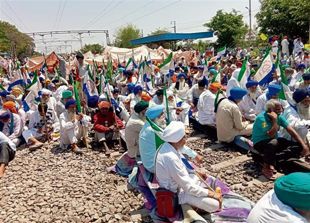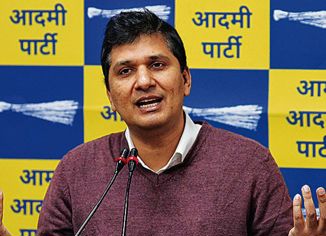
Photo: Vicky Gharu
Vandana Shukla in Bhaini Sahib
Survival of fine arts such as music has often been brought into question soon after patron-gurus depart. This was apparent when Namdhari sect matriarch Chand Kaur was shot dead on April 4. The murder triggered a succession war within the family, already caught in a void since the death of Satguru Jagjit Singh in December 2012. More than anything else, the losses were seen as a severe setback to the rich tradition of music handed down for centuries.
Will this tradition survive the turmoil? Politics of succession, crime and music are not interlinked. The followers of a unique tradition of classical music, though, find themselves entrapped in memories of notes. Late Satguru Jagjit Singh incorporated a system that produced many illustrious protegee in Hindustani classical music and Gurmat Sangeet. He created a unique system of producing excellence in music through research and rigour. Melodious notes wafted across the homes of about 1,500 residents in Bhaini Sahib, clocked early morning by Asa ki baar, in noon by Gurubani kirtan, and the evening by an elaborate musical discourse on traditional music. For birth, marriage and even death, there was music. And, it was classical music in its purest form, presented to perfection. Sangeet Natak Akademi, New Delhi, honoured him by inducting him as a prestigious Tagore Fellow of the Akademi for his contribution to the classical music and dance. Many maestros believed he was better than them, for his pursuit of music was saintly; neither for fame nor for commercial gains. His exit changed the symphony. “There are things that surround us from all sides. Yes, there is music, but his genius is missed. The tradition goes on,” says Gurdayal Singh, a vocalist and sitarist, who recently became a shagird of Ustad Shahid Parvez.
The legacy of a medley of tantri vadya (stringed instruments), percussion and kirtan not only offers solace, it helps emote, express and heal his musical protégés at different levels. “Intrigues are often hatched by family members in religious sects -- this has happened with many gurus, even Shams was killed by Rumi’s son. It’s the disciples who know the guru and carry the legacy, not a family,” says another musician.
The tradition has survived because their late Satguru ensured that followers of his faith, irrespective of the profession, must learn music, even for a while. The lessons started as early as age three, following a rigorous routine. The promising ones were selected and sent to stay with maestros like Pt Hari Prasad Chaurasia, Pt Shiv Kumar Sharma and Pt Rajan Sajan Mishra. He paid for their living expenses to keep them away from distractions of making a living. On completion of training, the pupils would return to the dera to train young disciples; as seva, not as profession. They would perform to propagate music, not for business.
The reverence for music was encouraged among Namdharis spread across India and overseas, the same way. Rajesh Malaviya, who lived in Namdhari dharmshala in Mumbai, a disciple of late tabla maestro Ustad Alla Rakha Khan, came to Bhaini Sahib in 1992 and has been teaching percussion ever since. His two daughters; 16- year-old Ratna learns sitar under the tutelage of Pt. Virendra Kumar, a disciple of late Ustad Vilayat Khan, and 6-year-old Ragini is learning to play the dilruba. They are not Namdharis but music makes them inseparable from other Namdhari girls, all dressed in traditional white. They too cover their heads with dupatta. The young girls and boys have their instruments customised for riyaaz. Ragini and Hardev Kaur, accompany others on their miniature dilrubas, rendering kirtan.
Disciples say their present Satguru Uday Singh, a nephew of the late Sadguru Jagjit Singh, too learnt music and takes interest in the work of the music academy: conferences are held the same way, gifted kids are sent for shagirdi. But the number of students learning music has dwindled. In 2009, there were close to 150 children from all castes and socioeconomic brackets, now, about 43 girls and 8 boys from the community come to learn music, free of cost. The rigour is also somewhat relaxed. “He woke us up at 2am, and would call up himself.”
A few outsiders, among them professors of music, also come from Amritsar, Jalandhar and Hoshiarpur. They learn about the extinct instruments like rabab, saranda and taar shehnai (played with a bow), still played in concerts at Bhaini Sahib.
Harjinder Singh, a disciple of Ustad Amjad Ali Khan, plays the sarod and five different types of rabab. “Traditional kirtan was done on the accompaniment of saranda and rabab, in Dhrupad and rababi styles. Satguru Jagjit Singh took great pains to get the rababs made in their original form; he tracked down rababis in Pakistan,” says Harjinder.
Rabab has limitations for accompaniment of the intricacies of classical rendering, hence few learn it. Harjinder is among a very few who play this instrument. Kripal Singh Panesar, settled in England, and Baljeet Singh play the rare taar shehnai, learnt under the tutelage of late Ustad Bismillah Khan.
In the academy of music, a new building that came up in the memory of late Satguru Jagjit Singh, the musical notes continue to mesmerize. Girls clad in white sing a composition of Ustad Harbhajan Singh in raga Megh, ‘e sakhi ri sawan aaya’, in well synchronised full throated voice, not even one in the group misses the intricate tans and slides, while playing difficult musical instruments like dilruba, sarod, santoor, sitar and flute. The youngest is aged 7, the oldest 17. This is one place where girls play male instruments like sarangi and sarod. They also sing the kirtan in religious ceremonies. “Things may change, but music will remain our lifeline; the only way to please our guru is music; rendered with devotion and beauty.”



























